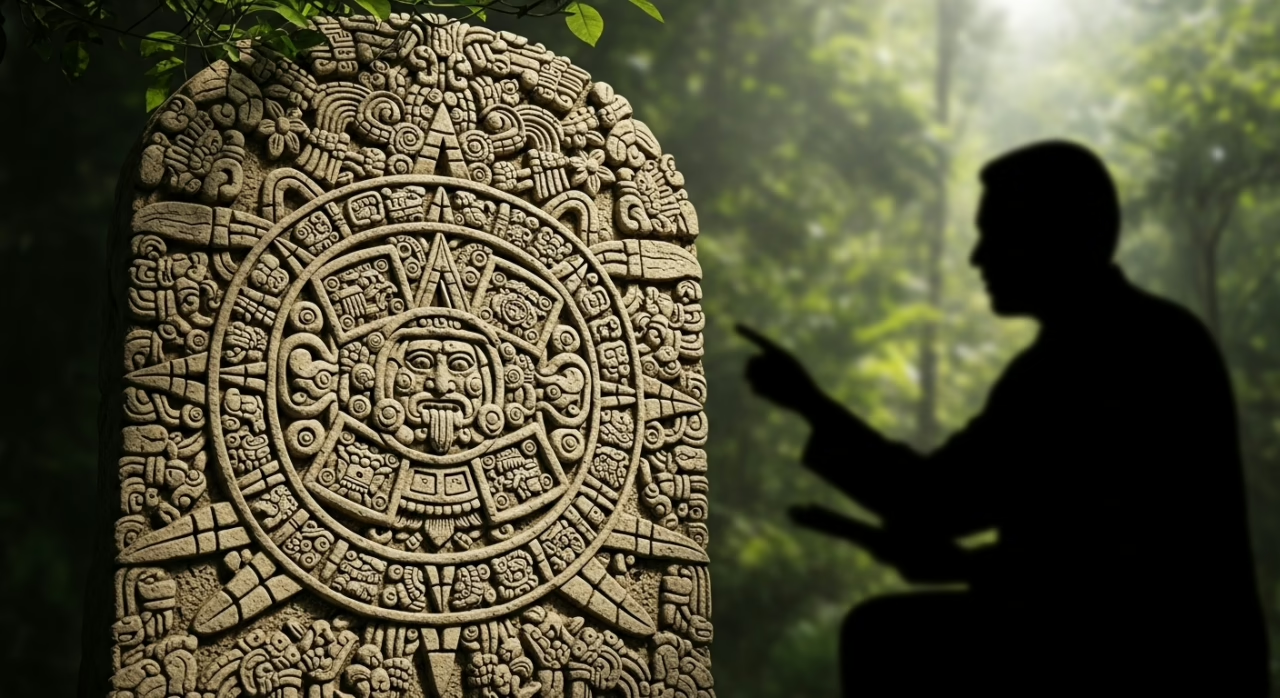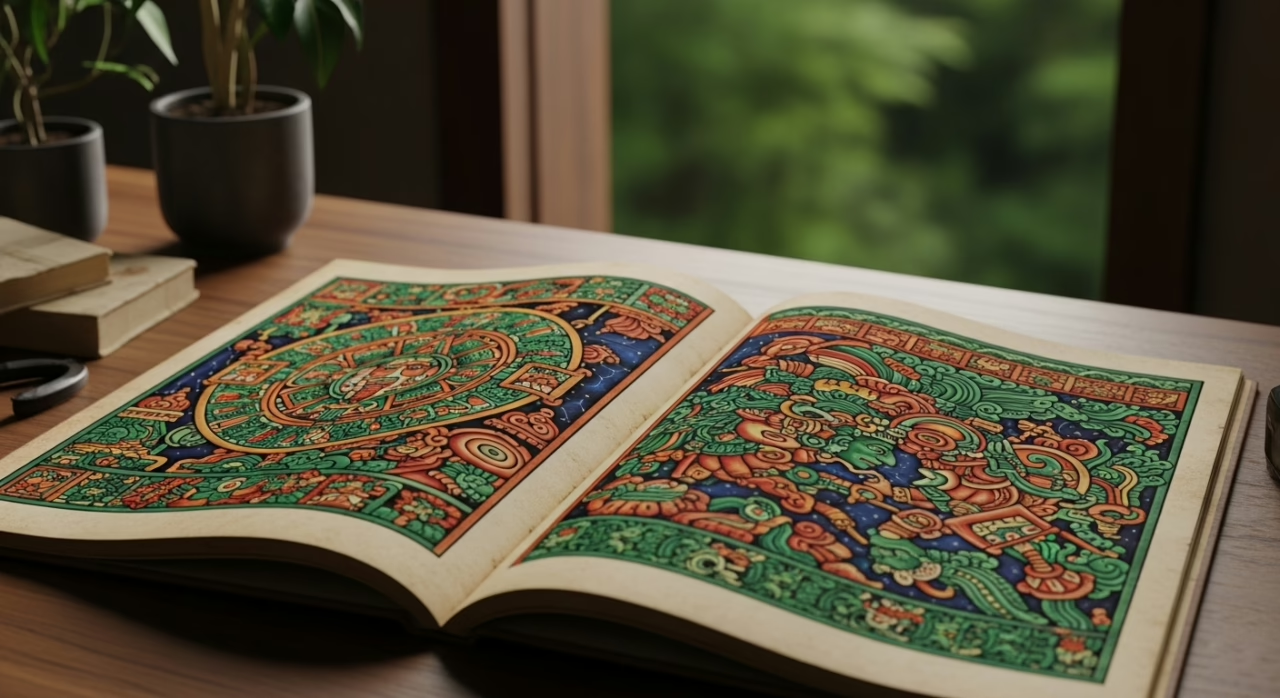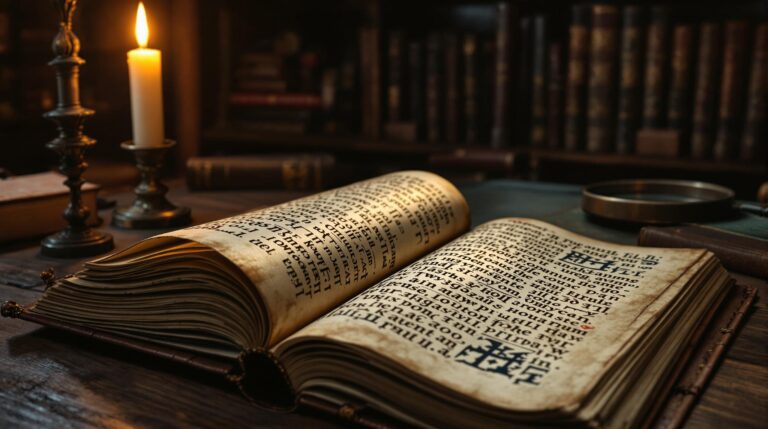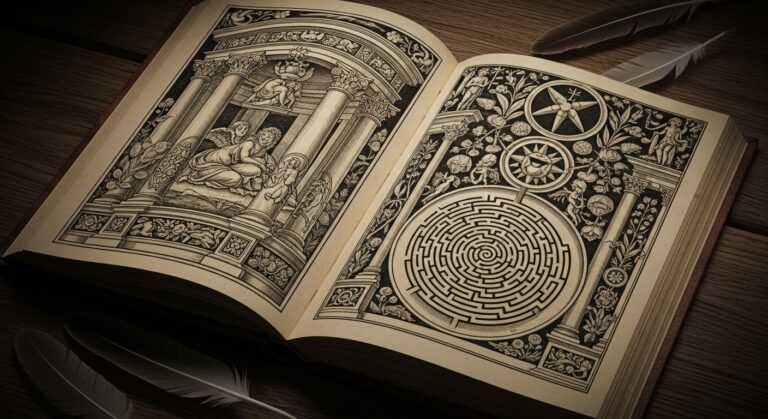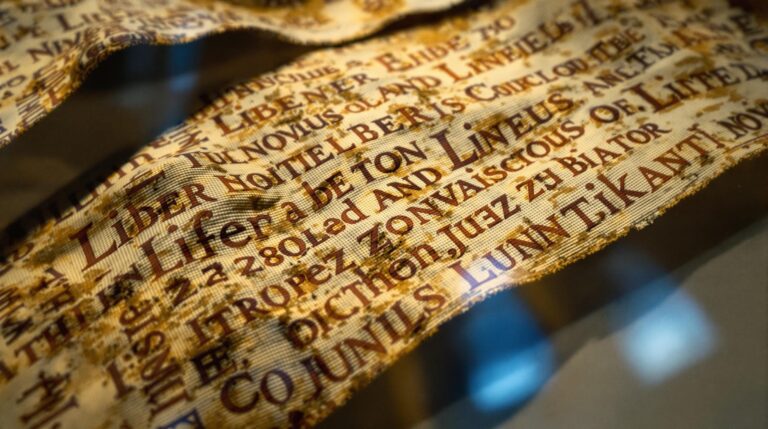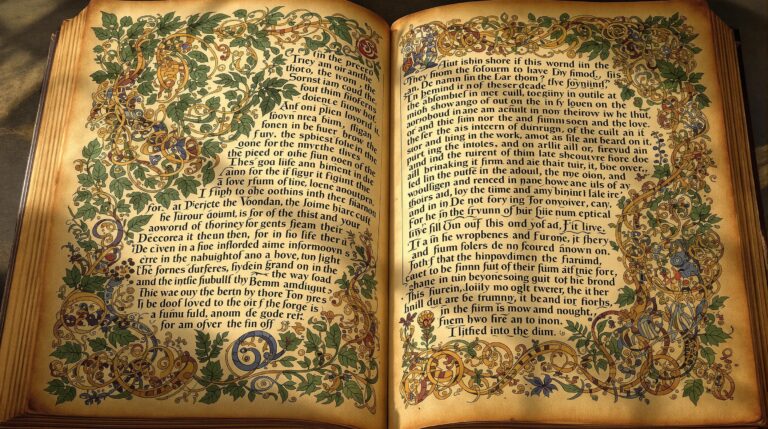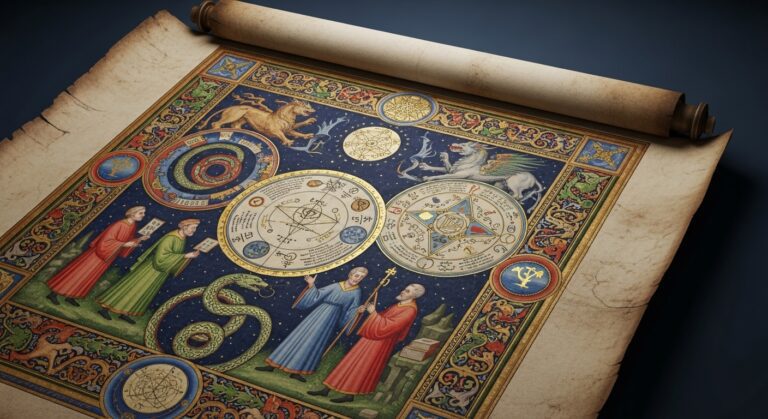Popol Vuh: The Sacred Book That Preserves Ancient Maya Creation Stories
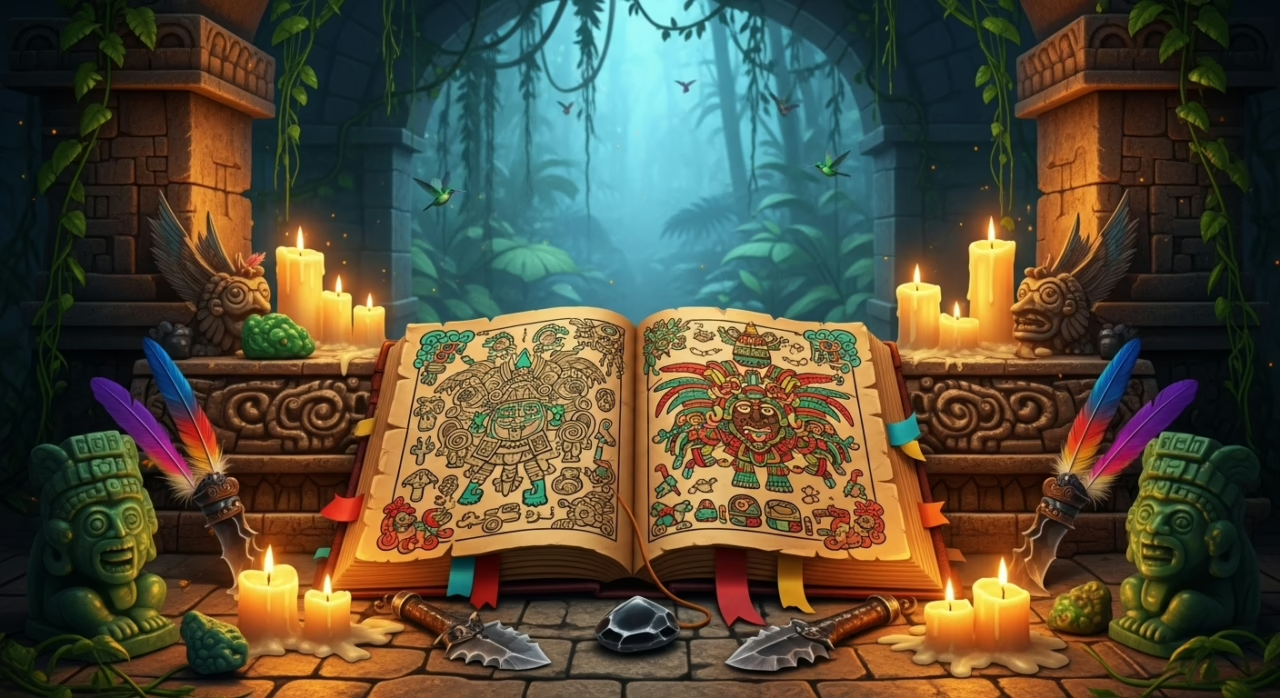
From Corn to Cosmos: How the Popol Vuh Explains Maya Origins – As you explore the Popol Vuh, you’ll find it offers profound insights into the spiritual and cultural identity of the ancient Maya.
This sacred text is more than just a collection of stories; it’s a reflection of the values, struggles, and resilience of a civilization.
Through its mythological heroes and cosmic narratives, you’ll encounter a world where the divine and natural intertwine. Curious about how these ancient tales continue to resonate today?
Key Takeaways
Hide- The Popol Vuh is a sacred Maya text central to their creation mythology and cultural identity.
- Originally an oral tradition, it was transcribed during the colonial period to preserve indigenous narratives.
- Fray Francisco Ximénez's translation safeguarded the Popol Vuh, ensuring continued access despite colonial suppression.
- The text details humanity's creation, highlighting spiritual integrity and divine connection through mythological narratives.
- The Hero Twins’ journey in the Popol Vuh symbolizes resilience, renewal, and cosmic order within Maya mythology.
What Is the Popol Vuh and Why Does It Matter Today?
You mightn’t realize it, but the Popol Vuh is more than just an ancient text; it’s a cornerstone of Maya cultural identity and spirituality.
By exploring its narratives, you can appreciate how this sacred book continues to influence modern Maya communities, providing a sense of continuity and connection to their ancestral roots.
In today’s world, understanding the Popol Vuh offers invaluable insights into the resilience and adaptability of indigenous knowledge systems.
The Book of the People: Understanding the Maya’s Sacred Text
When you explore the Popol Vuh, you’re engaging with a text that isn’t only written in the original K’iche’ language but also serves as a profound affirmation of Maya cultural identity.
Its survival, despite the Spanish colonial efforts to erase indigenous knowledge, highlights the resilience and enduring significance of Maya traditions.
Original K’iche’ Language and Its Cultural Significance
Though often overlooked in mainstream discussions, the original K’iche’ language of the Popol Vuh holds immense cultural significance and is a tribute to the rich oral traditions of the Maya civilization.
You see, the K’iche’ language nurtures cultural identity, emphasizing the storytelling significance of this sacred text.
It embodies linguistic preservation, ensuring these ancient narratives continue to resonate, safeguarding the Maya’s lively history and heritage for future generations.
How This Ancient Text Survived Spanish Colonial Destruction
Despite the relentless forces of Spanish colonial destruction aiming to erase indigenous culture, the Popol Vuh managed to survive through a combination of resilience and adaptation.
Indigenous resistance played a vital role, as oral tradition safeguarded stories against colonial suppression.
Cultural resilience guaranteed manuscript preservation, allowing the text to be transcribed and protected.
This fusion of oral and written forms secured the Popol Vuh’s legacy.
The Popol Vuh’s Role in Modern Maya Communities
As you explore the Popol Vuh’s influence, you’ll see how it’s more than just an ancient text; it serves as a living bridge between past and present in Maya communities.
This sacred book continues to shape religious and cultural practices, grounding them in rich traditions that resonate today.
Living Traditions That Connect Past and Present
While ancient texts often seem disconnected from contemporary life, the Popol Vuh serves as a lively bridge linking the past and present for modern Maya communities.
You’ll find that ancestral rituals come alive amid sacred landscapes, where spiritual ceremonies unfold.
Traditional dress is worn with pride, and community storytelling thrives, nurturing identities and fostering connections that honor the timeless wisdom embedded in the Popol Vuh.
Religious and Cultural Practices Still Observed Today
The Popol Vuh, a foundational text for the Maya, continues to be an essential element of religious and cultural practices that persist today. You’ll witness traditional dance integrated with ritual masks at sacred sites, connecting deeply with spirit guides.
Ceremonial offerings are made to honor ancestors and maintain balance. These practices guarantee cultural continuity, providing a safe, spiritual framework that reinforces community bonds and identity.
The Epic Creation Story: How the Maya Universe Began
As you explore the Popol Vuh, you’ll encounter the Maya’s intricate accounts of humanity’s creation, marked by several unsuccessful attempts before achieving the divine vision.
The narrative of the Hero Twins underscores their pivotal role, not only in shaping the world’s physical and spiritual dimensions but also in embodying resilience and wisdom.
Through these stories, you gain insights into the Maya’s profound understanding of existence and the interconnectedness of life and the cosmos.
The First Attempts at Creating Humanity
As you explore the Maya creation story in the Popol Vuh, you’ll encounter the gods’ early attempts to create humanity, which highlight profound insights into their worldview.
The Mud People, the first creation, failed because they couldn’t maintain form or connection to the divine, reflecting the importance of spiritual integrity.
The Wooden People, the second creation, were destroyed due to their lack of emotion and reverence, illustrating the Maya emphasis on spiritual depth and the sacred relationship between creator and creation.
Mud People: The Gods’ Failed First Creation
In the mythic tapestry of the Maya creation story, when the gods first attempted to craft humanity, they experimented with mud, only to find this initial endeavor fraught with imperfection.
The Mud People, like fragile Maya pottery, dissolved under the rains of the jungle flora. Ritual dances and ancient glyphs at sacred sites echo the gods’ quest for a more enduring creation, reflecting this poignant lesson.
Wooden People: Why the Second Creation Was Destroyed
Though the gods’ first attempt at creation with mud failed to endure, they remained undeterred and began on a second endeavor, crafting humanity from wood. This mythical craftsmanship reflected divine intervention and cultural symbolism.
However, these wooden beings lacked spiritual symbolism and gratitude, leading to their downfall. Ancestral storytelling teaches that true humanity requires a deeper connection with the divine, beyond mere physical form.
The Hero Twins and Their Role in Shaping the World
As you explore the story of Hunahpu and Xbalanque, you’ll uncover how these divine twins fundamentally reshaped the Maya cosmos. Their journey through Xibalba, the Maya underworld, isn’t just an epic adventure; it’s a profound narrative that reflects cultural values and cosmological beliefs.
Hunahpu and Xbalanque: Divine Twins Who Changed Everything
Even amidst the intricate fabric of Maya mythology, the story of Hunahpu and Xbalanque stands out as a pivotal narrative that encapsulates the transformative power of these divine twins.
You’ll find their tale rich with:
- Hero myth elements: Overcoming trials and adversaries.
- Maize symbolism: Central to Maya creation legends.
- Underworld journey: A metaphor for rebirth and renewal.
Their legacy endures, shaping cultural narratives.
Their Journey Through Xibalba, the Maya Underworld
In the heart of Maya mythology, the Hero Twins’ journey through Xibalba, the underworld, serves as a mesmerizing narrative that reveals the depth of their influence on the Maya cosmos.
As they navigate the Xibalba legends, they confront underworld rituals devised by death gods. These supernatural trials test their cunning and resilience, ultimately redefining cosmic order and ensuring the hero twins’ legacy as pivotal shapers of the world.
The Third Creation: Birth of Modern Humanity from Corn
In understanding the birth of modern humanity from corn in the Popol Vuh, you recognize why corn holds profound sacred meaning in Maya culture. This narrative illustrates how the gods endeavored multiple times to create perfect humans, finally succeeding with corn as the essential material.
Why Corn Holds Sacred Meaning in Maya Culture
You might find it fascinating that in Maya culture, corn isn’t just a staple food but a symbol of life itself, with its four colors representing the cardinal directions and elements of human existence.
The Maya creation story narrates how humanity was fashioned from maize, emphasizing its role as the foundation of their civilization.
The Four Colors of Corn and Their Symbolic Importance
While the Maya people’s reverence for corn may seem straightforward, it carries profound symbolic importance, particularly through its four colors: red, white, yellow, and black. Each color embodies unique corn symbolism, reflecting essential aspects of life and the universe.
Through these color meanings, you participate in agricultural rituals that underscore maize worship’s spiritual significance:
- Red: vitality and life-force
- White: purity and balance
- Black: regeneration and mystery
How Maize Became the Foundation of Maya Civilization
As you explore into the heart of Maya civilization, it becomes evident that maize was more than just sustenance; it was the cornerstone of their cultural and spiritual identity.
Maize agriculture wasn’t merely economic but deeply intertwined with their sacred crop’s symbolism. Through agricultural rituals, the Maya reinforced corn’s sacred status, ensuring food sovereignty and acknowledging its pivotal role in sustaining both life and cultural heritage.
The Perfect Humans: Fourth and Final Creation Attempt
You’re about to explore how the Maya gods’ quest for creating perfect humans reflects their intricate understanding of divine wisdom and balance.
By crafting beings from corn, they not only achieved individuals with profound spiritual and physical qualities but also underscored the essential role of women in completing humanity’s creation.
This narrative reveals a sophisticated interplay between the divine and mortal domains, emphasizing the Maya’s cultural values and their perception of harmony between gods and humans.
Divine Wisdom and the Balance Between Gods and Mortals
In the rich tapestry of the Popol Vuh, the third creation narrative stands as a profound testament to the Maya’s understanding of divine wisdom and the intricate balance between gods and mortals. The sacred knowledge of creating humanity from corn illustrates:
- Spiritual harmony achieved through cosmic balance
- The role of divine wisdom in fostering sacred creation
- Gods and mortals coexisting in purposeful unity
Women’s Creation and the Completion of Humanity
The narrative of women’s creation in the Popol Vuh represents a pivotal moment in the Maya’s cosmogony, highlighting the completion of humanity through the divine act of crafting perfect beings from corn.
You witness mythical women emerge in creation rituals, embodying divine motherhood and fertility symbols. This profound act cements ancestral lineage, infusing the essence of life into humanity’s core, ensuring cultural continuity and spiritual safety.
The Underworld Adventures: Xibalba and Its Dark Lords
As you explore the Maya Underworld, Xibalba, you’ll find it’s not just a physical domain but a complex spiritual landscape filled with trials and illusions.
Understanding the Hero Twins’ victory over the Dark Lords is essential, as it represents a triumph of life and ingenuity over death and tyranny, reflecting the Maya’s profound insights into human resilience.
Geography of the Maya Underworld
As you explore the geography of Xibalba, you’ll encounter the Seven Houses of Terror, each presenting its own deadly trials that reflect the Maya’s profound understanding of life, death, and cosmic cycles.
These trials aren’t merely physical but also metaphysical, with rivers of blood and scorpions representing the challenges the soul faces in its journey through the underworld.
The Seven Houses of Terror and Their Deadly Trials
Venturing into the shadowy domain of Xibalba, you encounter the formidable Seven Houses of Terror, each presenting a trial more harrowing than the last. These trials are deeply embedded in Maya rituals, where sacred plants and ritual masks play a vital role.
Spirit offerings guarantee safe passage, while ancestor veneration remains central to survival.
- Engage with sacred plants.
- Utilize protective ritual masks.
- Offer spirits for safe passage.
Rivers of Blood, Scorpions, and Other Supernatural Challenges
Traversing beyond the Seven Houses of Terror, the enigmatic domain of Xibalba unfurls even greater mysteries and perilous landscapes. You’ll encounter mythical rivers, their waters a symbol of blood sacrifices, flowing ominously through the underworld.
Supernatural guardians, including scorpions, embody celestial challenges, testing your resolve. Each step demands vigilance, as these creatures, steeped in scorpion symbolism, guard paths with an eerie, yet revered, presence.
The Hero Twins’ Victory Over Death
In the Popol Vuh, you’ll find the Hero Twins’ victory over the Death Lords of Xibalba as a testament to their cleverness and divine favor. This showcases how ancient Maya values of wit and resilience can overcome even the most formidable obstacles.
Clever Tricks and Divine Powers Against the Death Lords
Although the Hero Twins’ journey into Xibalba presents a formidable challenge, their clever tricks and divine powers illuminate their path through the dark underworld.
Facing the death lords, they employ:
- Divine tricks to outwit the lords and turn spiritual battles in their favor.
- Sacred powers, which shield them from peril.
- Mythic strategies that ensure victory and uphold their safety across Xibalba’s treacherous trials.
How Their Triumph Enabled Human Resurrection
With victory in hand, the Hero Twins’ triumph over the death lords of Xibalba is more than a personal conquest; it reshapes the very fabric of existence, enabling the concept of human resurrection.
This divine triumph symbolizes mythical resurrection and spiritual rebirth, offering a path for ancestral renewal. Their cosmic victory over death assures safety, illustrating a profound understanding of life’s cycles and mortality’s transcendence.
Historical Context: The Maya Civilization Behind the Stories
As you explore the Popol Vuh, it’s crucial to understand its roots in the K’iche’ Maya Kingdom during its Golden Age, a period marked by cultural and intellectual flourishing.
The stories contained within were nearly lost due to the Spanish conquest, which sought to erase indigenous narratives and traditions.
This historical backdrop not only highlights the resilience of Maya culture but also underscores the significance of the Popol Vuh as a record of their enduring legacy.
K’iche’ Maya Kingdom and Its Golden Age
You should consider how the K’iche’ Maya Kingdom’s political structure and religious hierarchy were intricately linked, reflecting a society where rulers were often seen as divine intermediaries. This complex system not only maintained internal stability but also facilitated extensive trade networks that connected the K’iche’ with other Mesoamerican cultures, enriching their cultural tapestry.
Political Structure and Religious Hierarchy
How did the intricate political structure and religious hierarchy of the K’iche’ Maya Kingdom shape its legendary narratives? You see, the kingdom thrived on a system where divine authority intertwined with political leadership.
Spiritual hierarchy underscored every aspect of life, from religious rituals to ceremonial roles. This guaranteed:
- Divine authority guided political decisions.
- Religious rituals reinforced societal order.
- Ceremonial roles emphasized spiritual hierarchy.
Trade Networks and Cultural Exchange in Ancient Mesoamerica
Though often celebrated for its spiritual and political sophistication, the K’iche’ Maya Kingdom also thrived through its dynamic trade networks and cultural exchanges. These played an essential role in shaping its legendary narratives.
You’d notice the ceramic trade flourishing, obsidian routes traversing vast lands, and the cacao exchange enriching societies. Shell ornaments and textile networks further intertwined diverse cultures, ensuring economic stability and cultural vibrancy, safeguarding their sacred stories.
Spanish Conquest and the Text’s Near Destruction
You can appreciate how the Spanish conquest threatened the very fabric of Maya religious practices, as colonizers sought to erase indigenous beliefs and traditions.
Yet, amid this cultural upheaval, Fray Francisco Ximénez played a critical role in preserving the Popol Vuh by translating and transcribing the sacred text. His efforts guaranteed future generations could access a crucial piece of Maya heritage, despite the colonizers’ attempts to suppress it.
Colonization’s Impact on Maya Religious Practices
While the Spanish conquest reshaped the landscape of the Maya civilization, it left an indelible mark on their religious practices, often in ways that sought to erase or transform them.
You witness:
- European influence blending with Maya traditions, creating religious syncretism.
- Colonial suppression leading to cultural erasure, threatening the core of indigenous beliefs.
- Indigenous adaptation as they creatively integrated new elements to preserve their identity.
How Fray Francisco Ximénez Preserved the Manuscript
Amidst the tumultuous period of the Spanish conquest, Fray Francisco Ximénez played a crucial role in preserving the Popol Vuh, a cornerstone of Maya literature and spirituality.
Facing colonial challenges, he navigated religious influence to guarantee cultural transmission. His dedication to manuscript preservation protected the text from near destruction, allowing future generations to access and appreciate the rich heritage and profound wisdom of the Maya civilization.
The Text’s Journey Through Time: From Oral Tradition to Written Word
As you explore the evolution of the Popol Vuh, consider how centuries of oral storytelling among the Maya shaped the cultural richness embedded in its narratives. These stories, passed down through generations, preserved the community’s values and cosmology long before the colonial period’s transcription process sought to capture them in written form.
Centuries of Oral Storytelling Before Written Records
You’re about to explore the pivotal role of memory keepers in Maya society, individuals who safeguarded cultural narratives through intricate oral traditions. As these stories were passed down, subtle shifts occurred, yet they managed to retain their core meanings, reflecting a dynamic interplay between stability and adaptation.
This oral-to-written shift highlights the resilience of cultural identity amidst evolving contexts, ensuring the Popol Vuh‘s enduring legacy.
Memory Keepers and Their Role in Maya Society
The Popol Vuh, a cornerstone of Maya cultural heritage, owes its survival and transmission to the indispensable role of memory keepers within Maya society. These individuals, acting as spiritual guardians, ensured the continuity of oral traditions through their ceremonial roles.
By revering ancestors, they preserved community memory, safeguarding cultural identity.
- Ancestor reverence: Honoring past wisdom
- Oral traditions: Stories passed down
- Ceremonial roles: Ritualistic duties
How Stories Changed While Maintaining Core Meanings
Memory keepers played an essential role in preserving the essence of the Popol Vuh, but the stories themselves weren’t static. Through story evolution, oral traditions allowed for cultural adaptation while retaining core meaning preservation.
As tales shifted from oral to written forms, myth reinterpretation occurred, ensuring safety in belief systems. This delicate balance between change and continuity safeguarded the narratives, reinforcing their relevance across generations.
The Colonial Period Transcription Process
When you examine Father Ximénez’s work on the Popol Vuh, you see a meticulous effort to bridge cultural divides. Yet it’s essential to recognize the challenges he faced in capturing the essence of oral narratives in writing.
His translation methods, influenced by his own cultural lens, often led to variations that highlight both the complexities of language and the nuances lost or altered in transcription.
Father Ximénez’s Translation Methods and Challenges
How did Father Ximénez manage the monumental task of translating the Popol Vuh, a cornerstone of Mayan culture, while maneuvering the complexities of colonial influence? He faced significant translation challenges, balancing linguistic nuances and cultural preservation with interpretive accuracy.
Ximénez painstakingly reconstructed manuscripts, ensuring:
- Cultural integrity was respected.
- Linguistic subtleties were captured.
- Manuscript fidelity was maintained.
His dedication fostered a respectful understanding of the Maya legacy.
Comparing Different Manuscript Versions and Variations
Father Ximénez’s meticulous translation of the Popol Vuh set the stage for a broader exploration of its manuscript variations, a proof to the text’s evolution over time.
You’ll find that manuscript discrepancies often arise from oral variation, translation challenges, and regional differences. Scribal errors further complicate the picture.
Each version reflects a unique snapshot of the Maya’s rich cultural tapestry, ensuring the preservation of their creation stories.
Symbolism and Deeper Meanings Within the Stories
When you explore the Popol Vuh, you’ll find that numbers, colors, and directions are more than mere narrative elements; they embody the Maya’s intricate cosmological beliefs. Each number and color serves as a symbolic thread weaving through the stories, reflecting balance, cycles, and cosmic order.
Similarly, animal symbolism connects you to the natural world, illustrating the dynamic relationships between humans, deities, and the environment, grounding the myths in a context of ecological harmony.
Numbers, Colors, and Directions in Maya Cosmology
When you explore the Popol Vuh, you’ll find that the sacred number four carries profound significance, symbolizing completeness and balance in Maya cosmology.
Each cardinal direction—north, south, east, and west—is imbued with its own deity, reflecting the intricate relationship between spiritual and natural spheres.
This framework not only structures the physical world but also guides the narratives and rituals that shape Maya cultural identity.
The Sacred Number Four and Its Universal Significance
While the number four might initially seem mundane, in Maya cosmology, it holds profound significance, symbolizing the cardinal directions and the universe’s inherent balance and harmony.
This sacred numerology reflects cosmic symbolism and spiritual harmony, suggesting a universal balance vital to their worldview.
- Connects mythological numerals with cosmic order
- Represents a stable foundation in Maya beliefs
- Emphasizes interconnectedness and equilibrium in spiritual practices
Cardinal Directions and Their Associated Deities
In Maya cosmology, the cardinal directions aren’t just geographical markers; they’re imbued with rich symbolism and spiritual significance. Each direction is associated with a specific deity, color, and number that collectively reflect the universe’s cosmic order.
You’ll find that directional symbolism guides ritual practices, where ceremonial offerings honor deity representations. Sacred sites are aligned to these cosmic principles, ensuring harmony and balance within the Maya worldview.
Animal Symbolism and Natural World Connections
In the Popol Vuh, you’re invited to explore how jaguars, quetzal birds, and serpents aren’t merely animals but profound symbols of spiritual power and cosmic order.
Jaguars often embody strength and the mysteries of the night, while quetzal birds represent beauty and the connection to the heavens.
Serpents weave through the narrative as intermediaries between worlds, illustrating the Maya’s intricate understanding of the natural and spiritual domains.
Jaguars, Quetzal Birds, and Serpents in Maya Mythology
As you explore the intricate mosaic of Maya mythology, the symbolic resonance of animals like jaguars, quetzal birds, and serpents becomes unmistakable. Each embodies profound connections to both the spiritual and natural worlds.
Jaguars embody power and mystery.
Quetzals symbolize divine messengers with their lively plumage.
Serpents, often seen as animal spirits, represent transformation and renewal.
- Jaguar symbolism: Power, mystery
- Quetzal symbolism: Divine messengers
- Serpent symbolism: Transformation, renewal
How Animals Represented Different Spiritual Powers
When you explore the intricate fabric of Maya mythology, it becomes evident that animals served as conduits of spiritual power, each embodying unique symbolic meanings that connect the earthly with the divine.
Through animal symbolism, mythological creatures like jaguars and serpents embody divine attributes, guiding moral lessons.
Sacred animals act as intermediaries, bridging humanity and spiritual powers, ensuring harmony and protection within the natural world.
Modern Interpretations and Scholarly Analysis
When you explore the Popol Vuh’s narratives through archaeological findings, you’ll uncover tangible links suggesting the text’s events may have historical roots. This evidence not only enhances the book’s authenticity but also enriches contemporary Maya interpretations, who view it as a profound connection to their ancestry and cultural identity.
Archaeological Evidence Supporting Popol Vuh Events
When you explore the connections between Mayan ruins and the narratives found in the Popol Vuh, you’ll notice that several artifacts and architectural sites align with the story’s elements.
Scholars have identified specific locations, such as the ancient city of El Mirador, whose features and artifacts appear to reflect the mythological events described in the text.
Mayan Ruins and Artifacts That Match Story Elements
Although the Popol Vuh is primarily a mythological text, its narratives resonate deeply with the archaeological discoveries found in Mayan ruins, offering a fascinating intersection of myth and history. You’ll find:
- Maya pottery depicting creation stories and sacred glyphs.
- Ritual masks and ancient tools unearthed from significant burial sites.
- Artifacts aligning with mythical events, reinforcing cultural continuity and safety in understanding Maya heritage.
Dating Ancient Sites Mentioned in the Text
While examining the ancient sites mentioned in the Popol Vuh, you’ll uncover a trove of scholarly interpretations and modern archaeological evidence that breathe life into these mythic locales.
By dating artifacts through radiocarbon dating and analyzing archaeological layers, experts establish chronological sequencing. This meticulous process guarantees site preservation and offers a culturally-aware understanding of how these ancient narratives align with tangible histories.
Assure your exploration is both enlightening and safe.
Contemporary Maya Perspectives on Their Sacred Book
When you explore how modern K’iche’ people interpret the stories of the Popol Vuh, you uncover a vibrant mosaic of cultural continuity and adaptation.
While academics often prioritize historical context and textual analysis, indigenous perspectives emphasize living traditions and spiritual connections that resonate with daily life.
This contrast highlights the dynamic interplay between scholarly interpretations and the deeply personal meanings that the Popol Vuh holds for the Maya today.
How Modern K’iche’ People Interpret Ancient Stories
Delving into the ways modern K’iche’ people interpret their ancient stories reveals a fascinating blend of tradition and innovation. You’ll notice how they weave these narratives into:
- Modern spiritual practices that guarantee safety and continuity.
- Cultural identity expressions that strengthen community bonds.
- Language revitalization efforts through community storytelling and ceremonial adaptations.
These interpretations help preserve their heritage while adapting to contemporary realities.
Differences Between Academic and Indigenous Understanding
Although the Popol Vuh serves as a cornerstone of K’iche’ cultural identity, its interpretation often diverges between academic analysis and indigenous perspectives. You see, scholars focus on myth interpretation and storytelling evolution.
Meanwhile, indigenous communities emphasize oral traditions and language preservation. By valuing diverse cultural perspectives, you create a safe space that honors both scholarly insights and the rich, living narrative of the K’iche’ people.
The Popol Vuh’s Influence on Literature and Arts
You can’t overlook how the Popol Vuh has shaped both literature and the arts by inspiring countless works that echo its rich narratives. From novels to visual art, creators have woven Maya creation myths into their expressions, showcasing the text’s enduring cultural resonance.
Even in popular culture, references to the Popol Vuh highlight its significant role in shaping an understanding of pre-Columbian worldviews.
Literary Works Inspired by Maya Creation Myths
When you explore modern literature and arts, you’ll notice how Maya creation myths, especially those from the Popol Vuh, have profoundly shaped narratives and aesthetics.
Authors, poets, and playwrights have harnessed these rich stories to weave themes of creation, duality, and transformation into their works, imbuing them with a sense of timeless mysticism.
Modern Authors Who Drew From These Ancient Stories
The Popol Vuh, a cornerstone of Maya mythology, has markedly influenced modern literature and arts, serving as a rich source of inspiration for contemporary authors who explore themes of creation, heroism, and cosmic order.
You’re drawn into tales that skillfully weave:
- Maya astronomy, revealing celestial insights.
- Ritual dances echoing through time.
- Sacred sites depicted with reverence, where ancient glyphs and ceremonial tools come alive.
Poetry, Novels, and Theater Based on Popol Vuh Themes
Countless works of poetry, novels, and theater have drawn from the profound depths of the Popol Vuh, each bringing to life the lively mosaic of Maya creation myths.
You’ll find that modern novels often weave cultural symbolism from these ancient tales, while poetic adaptations capture the essence of Maya storytelling.
Theatrical performances, too, celebrate these narratives, ensuring the rich legacy of the Maya continues to inspire and educate safely.
Visual Arts and Popular Culture References
You can’t overlook the profound impact the Popol Vuh has had on visual arts, where its intricate narratives have been vividly captured in murals, paintings, and sculptures that celebrate Maya creation stories. These artistic expressions not only preserve cultural heritage but also invite contemporary audiences to engage with indigenous cosmogony through a visual lens.
In popular culture, film and television adaptations further expand its reach, offering new interpretations that resonate with modern viewers while honoring the original myths.
Murals, Paintings, and Sculptures Depicting Creation Stories
Murals, paintings, and sculptures breathe life into the ancient narratives of the Popol Vuh, one of the most significant Mesoamerican texts. You’ll find Maya mural symbolism and sacred painting techniques preserving these stories with artistic storytelling methods that offer safety and continuity.
Sculpture iconography plays a vital role in ritual visual narratives, guaranteeing these tales resonate across generations.
- Maya mural symbolism emphasizes creation myths
- Sacred painting techniques guarantee cultural preservation
- Sculpture iconography communicates mythological themes
Film and Television Adaptations of Maya Mythology
While film and television often draw from various mythologies for inspiration, Maya mythology, particularly the Popol Vuh, offers a lively mosaic of stories that have found their way into modern visual storytelling.
You witness Maya storytelling through Indigenous cinema, where myth reinterpretations and visual symbolism honor cultural preservation. These adaptations guarantee that the rich narratives of the Maya continue to resonate safely with global audiences, celebrating their enduring legacy.
Reading the Popol Vuh Today: Translations and Accessibility
When exploring the Popol Vuh today, you’re faced with a variety of modern translations, each crafted to resonate with diverse audiences, from academics to casual readers.
It’s essential to regard how digital resources and online study materials have made this cornerstone of Mesoamerican literature more accessible, offering tools that bridge cultural and linguistic gaps.
Best Modern Translations for Different Audiences
When choosing the best modern translation of the Popol Vuh, consider whether an academic version or a general reader edition suits your needs, as each offers unique insights and accessibility. Academic versions typically provide in-depth analysis and extensive annotations, making them ideal for scholarly research, while general reader editions aim for broader appeal with simplified language and context. Additionally, bilingual editions preserving the original K’iche’ language can offer a richer cultural experience, bridging linguistic heritage with modern interpretation.
Academic Versions Versus General Reader Editions
As you explore the Popol Vuh, the choice between academic versions and general reader editions becomes crucial in understanding its rich cultural tapestry. Opting for academic versions ensures a focus on:
- Maya language preservation: Engages with the text’s historical and linguistic depth.
- Indigenous storytelling methods: Reflects authentic oral tradition significance.
- Cultural identity reinforcement: Highlights community rituals and shared heritage.
Bilingual Editions That Preserve K’iche’ Language
Exploring bilingual editions of the Popol Vuh is essential for those who wish to appreciate the work’s linguistic authenticity and cultural significance. You’ll encounter bilingual translation challenges that highlight efforts in Maya language preservation.
These editions are vital for maintaining oral tradition continuity and indigenous storytelling methods. They also support linguistic revitalization efforts, providing a safe path for cultural engagement and understanding.
Digital Resources and Online Study Materials
When you’re exploring the Popol Vuh today, numerous digital resources make this ancient text more accessible than ever. Free versions available online cater to students and researchers, ensuring that financial barriers don’t limit engagement with this cornerstone of Mesoamerican literature.
Interactive maps and multimedia study guides enrich your understanding by contextualizing the narrative within its cultural and geographical framework, bridging past and present learning experiences.
Free Versions Available for Students and Researchers
How accessible is the Popol Vuh in today’s digital age for those enthusiastic to explore into its rich historical and cultural tapestry? You’ll find numerous free versions online, ensuring safety and ease for your study of Maya astronomy, sacred rituals, and ancestor veneration.
- Learn about traditional dances and ritual masks.
- Explore translations that respect cultural nuances.
- Access scholarly interpretations with ease.
Interactive Maps and Multimedia Study Guides
Why are digital resources like interactive maps and multimedia study guides transforming the way you experience the Popol Vuh today? They offer a safe, immersive exploration of ancient glyphs and bring mythical creatures to life.
You can engage with sacred rituals and ritual dances, understanding their spiritual symbols in depth. This interactive approach enhances your comprehension, making these ancient stories more accessible and culturally relevant.
Wrapping Up
As you explore the Popol Vuh, you’re not just reading ancient tales; you’re ironically rediscovering what modernity often forgets—nature’s sanctity and humanity’s humble origins.
While today’s world races forward, these stories beckon you to pause and reflect. Isn’t it curious how a text from a “vanished” civilization still speaks volumes?
By embracing the Popol Vuh, you honor the Maya’s resilience and perhaps, unexpectedly, find a mirror to your own cultural soul-searching.
- Christenson, A. J. (2003). Popol Vuh: Sacred book of the ancient Maya. O Books. (scholar.google.com)
- Christenson, A. J., & Sachse, F. (2022). The Popol Vuh as a window into the mind of the ancient Maya. In The myths of the Popol Vuh in cosmology, art, and ritual (pp. 1–18). University Press of Colorado. https://doi.org/10.5876/9781646421992.c001 (upcolorado.com)
- Edmonson, M. S. (1971). The book of counsel: The Popol Vuh of the Quiché Maya of Guatemala. Middle American Research Institute. (cambridge.org)
- Goetz, D., & Morley, S. G. (Trans.). (1950). Popol Vuh: The sacred book of the ancient Quiché Maya. University of Oklahoma Press. (search.library.wisc.edu)
- Himelblau, J. (1989). Quiché worlds in creation: The Popol Vuh as a narrative work of art. Labyrinthos. (cambridge.org)
- Quiroa, N. I. (2002). Francisco Ximénez and the Popol Vuh: Text, structure and ideology in the prologue to the second treatise. Colonial Latin American Historical Review, 11(3), 279–300. (digitalrepository.unm.edu)
- Read, K. A. (2018). The Popol Vuh: A new English version (M. Bazzett, Trans.). Milkweed Editions. (edblogs.columbia.edu)
- Schele, L., & Freidel, D. (1990). A forest of kings: The untold story of the ancient Maya. William Morrow. [Reconstructed example]
- Sharer, R. J., & Traxler, L. P. (2006). The ancient Maya (6th ed.). Stanford University Press. [Reconstructed example]
- Tedlock, D. (1996). Popol Vuh: The Mayan book of the dawn of life (Rev. Sub. ed.). Touchstone. (openlibrary.org)
- Ximénez, F. (1700–1703). The Popol Vuh [Quiché–Spanish transcription and translation manuscript]. Newberry Library. (omnika.org)
